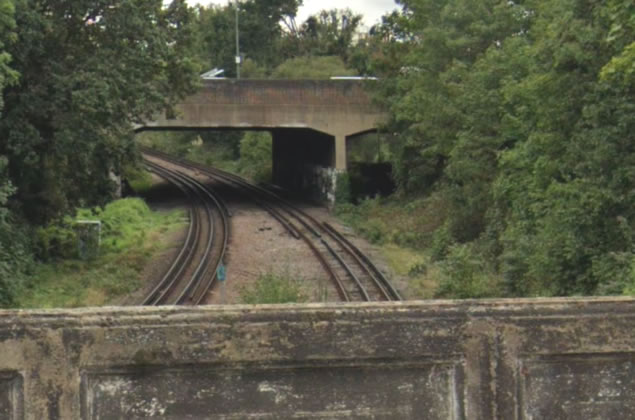Concerns Raised for Wildlife After Trackside Tree Felling
Residents believe habitats destroyed after clearance near Gunnersbury station

The trackside at Gunnersbury after the clearance
September 15, 2024
Concern has been raised that the recent clearance of trackside vegetation by Network Rail near Gunnersbury station has been over aggressive and destroyed a local green corridor for wildlife.
Residents of the area including those living in Chiswick Village were shocked to see what they describe as large scale felling of trees by the railway line near to the bridges.
It is claimed that this has destroyed the habitat for a significant number of birds who have nested in these trees for years as well as disturbing hedgehogs, bats and foxes putting them at risk of local extinction.
Wildflowers, such as bluebells also thrived at the location making a significant contribution to biodiversity in the area.
Some people living in the area have questioned why the removal of vegetation was so drastic and are angry that there was no consultation before trees were removed.
One resident said, “The felling appears to look quite reckless and also unlikely that wildlife has been rehomed or carefully moved. Are we able to object to this before all the trees are gone and it’s too late?
“Many trees would have been there for decades based on their height, so there must be a solution to prune as necessary while keeping some harmony and nature in its place.”

The trackside after clearance at Gunnersbury
Naturalists believe that railway lines provided vital green corridors through urban areas enabling pollinators like bumblebees to move between fragmented habitats. The trains discourage predators and the presence of humans, making it a unique environment for species that would other wise struggle in urban areas. Railway trackside areas provide a surprisingly diverse range of habitats for various types of wildlife. Wildflowers such as oxeye daisies, cowslips, and dandelions often flourish and the abundance of wildflowers provides nectar for many pollinators, such as butterflies (e.g., meadow brown, small tortoiseshell) and moths. Songbirds such as robins, wrens, and finches take advantage of the shrubs and trees along railway lines for nesting and feeding. Bats may forage along railway lines, taking advantage of the insects attracted to the vegetation and water bodies. Trees and old railway infrastructure like bridges can serve as roosting sites.
Network Rail has a responsibility to manage vegetation along the railway tracks in a way that ensures safety, train performance, and environmental protection. It is obliged to comply with wildlife protection laws which includes that there is no damage to active bird nests during the nesting season which is generally March to August. Conservation of Habitats and Species Regulations require it to avoid damaging habitats of protected species such as bats, hedgehogs or reptiles. It also must balance safety with biodiversity, aiming to preserve habitats for local wildlife while preventing overgrowth. Network Rail sometimes carries out environmental assessments before significant vegetation clearance to identify any protected or endangered species in the area and it says this was done before the work took place in Chiswick.

The trackside before the clearances. Picture: Google Streetview
The aggressive clearing of trees and vegetation has sparked protests in other parts of the UK including Sheffield. The resulting pressure has led Network Rail to say that it would review its policies, though some environmental campaigners say that vegetation is being cut back more than it should be to save money.
A Network Rail spokesperson said, “ Managing trees and vegetation is vital for the safety of passengers and track workers. Overgrown vegetation can block signals, come into contact with live electrical equipment, fall onto tracks, undermine track stability, or prevent staff from finding a safe place while trains pass. It also helps reduce leaves on the line, which can impact train braking and acceleration, causing delays and increasing accident risk, particularly in autumn.
“The planned vegetation work near Gunnersbury station is essential for maintaining safe and reliable train services. An ecology survey is undertaken before work begins to identify signs of animal activity, and steps are taken to minimise the impact of our work on wildlife.”
Like Reading Articles Like This? Help Us Produce More This site remains committed to providing local community news and public interest journalism. Articles such as the one above are integral to what we do. We aim to feature as much as possible on local societies, charities based in the area, fundraising efforts by residents, community-based initiatives and even helping people find missing pets. We've always done that and won't be changing, in fact we'd like to do more. However, the readership that these stories generates is often below that needed to cover the cost of producing them. Our financial resources are limited and the local media environment is intensely competitive so there is a constraint on what we can do. We are therefore asking our readers to consider offering financial support to these efforts. Any money given will help support community and public interest news and the expansion of our coverage in this area. A suggested monthly payment is £8 but we would be grateful for any amount for instance if you think this site offers the equivalent value of a subscription to a daily printed newspaper you may wish to consider £20 per month. If neither of these amounts is suitable for you then contact info@neighbournet.com and we can set up an alternative. All payments are made through a secure web site. One-off donations are also appreciated. Choose The Amount You Wish To Contribute. If you do support us in this way we'd be interested to hear what kind of articles you would like to see more of on the site – send your suggestions to the editor. For businesses we offer the chance to be a corporate sponsor of community content on the site. For £30 plus VAT per month you will be the designated sponsor of at least one article a month with your logo appearing if supplied. If there is a specific community group or initiative you'd like to support we can make sure your sponsorship is featured on related content for a one off payment of £50 plus VAT. All payments are made through a secure web site. |